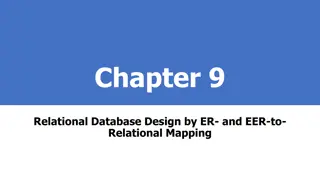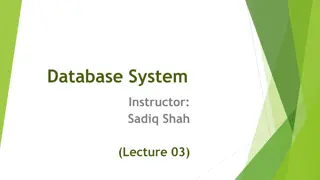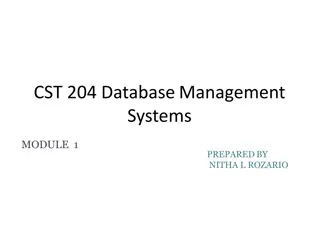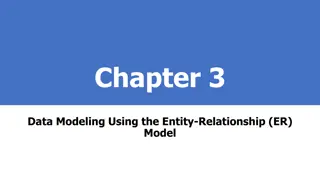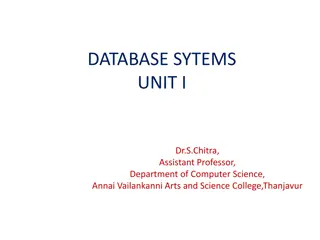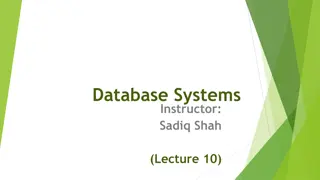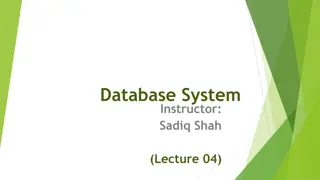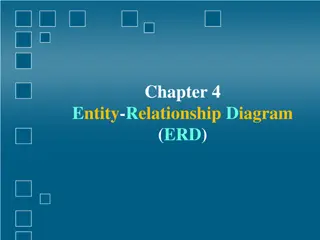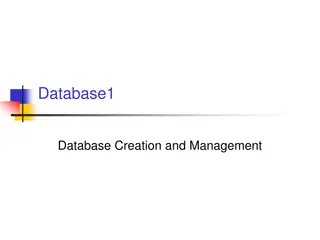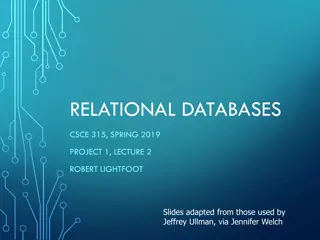Understanding Entity-Relationship Model in Database Systems
This article explores the Entity-Relationship (ER) model in database systems, covering topics like database design, ER model components, entities, attributes, key attributes, composite attributes, and multivalued attributes. The ER model provides a high-level data model to define data elements and relationships in a database system, facilitating a conceptual design of data.
Download Presentation

Please find below an Image/Link to download the presentation.
The content on the website is provided AS IS for your information and personal use only. It may not be sold, licensed, or shared on other websites without obtaining consent from the author. Download presentation by click this link. If you encounter any issues during the download, it is possible that the publisher has removed the file from their server.
E N D
Presentation Transcript
Name of the Faculty : Ms.R.RITA JENIFER Designation : Assistant Professor Department : Computer Science Contact Number : 75980 11228 Programme : B.Sc Computer Science Batch :2018-2021 Onwards Semester : IV Course Code :16SCCCS4 Course Title : Database Systems Unit : IV Topics Covered :Database Design, ER Model
ER MODEL ER model stands for an Entity-Relationship model. It is a high-level data model. This model is used to define the data elements and relationship for a specified system. It develops a conceptual design for the database. It also develops a very simple and easy to design view of data. In ER modeling, the database structure is portrayed as a diagram called an entity-relationship diagram. For example, Suppose we design a school database. In this database, the student will be an entity with attributes like address, name, id, age, etc. The address can be another entity with attributes like city, street name, pin code, etc and there will be a relationship between them.
ENTITY: An entity may be any object, class, person or place. In the ER diagram, an entity can be represented as rectangles. Consider an organization as an example- manager, product, employee, department etc. can be taken as an entity.
2. ATTRIBUTE The attribute is used to describe the property of an entity. Eclipse is used to represent an attribute. For example, id, age, contact number, name, etc. can be attributes of a student.
KEYATTRIBUTE The key attribute is used to represent the main characteristics of an entity. It represents a primary key. The key attribute is represented by an ellipse with the text underlined.
COMPOSITEATTRIBUTE An attribute that composed of many other attributes is known as a composite attribute. The composite attribute is represented by an ellipse, and those ellipses are connected with an ellipse.
MULTIVALUED ATTRIBUTE An attribute can have more than one value. These attributes are known as a multivalued attribute. The double oval is used to represent multivalued attribute. For example, a student can have more than one phone number.
DERIVEDATTRIBUTE An attribute that can be derived from other attribute is known as a derived attribute. It can be represented by a dashed ellipse. For example,A person's age changes over time and can be derived from another attribute like Date of birth.
MAPPING CONSTRAINTS A mapping constraint is a data constraint that expresses the number of entities to which another entity can be related via a relationship set. It is most useful in describing the relationship sets that involve more than two entity sets. For binary relationship set R on an entity set A and B, there are four possible mapping cardinalities. These are as follows: One to one (1:1) One to many (1:M) iii. Many to one (M:1) iv. Many to many (M:M) i. ii.
ONE-TO-ONE In one-to-one mapping, an entity in E1 is associated with at most one entity in E2, and an entity in E2 is associated with at most one entity in E1.
ONE-TO-MANY In one-to-many mapping, an entity in E1 is associated with any number of entities in E2, and an entity in E2 is associated with at most one entity in E1.
MANY-TO-ONE In one-to-many mapping, an entity in E1 is associated with at most one entity in E2, and an entity in E2 is associated with any number of entities in E1.
MANY-TO-MANY In many-to-many mapping, an entity in E1 is associated with any number of entities in E2, and an entity in E2 is associated with any number of entities in E1.
KEYS Keys play an important role in the relational database. It is used to uniquely identify any record or row of data from the table. It is also used to establish and identify relationships between tables. For example: In Student table, ID is used as a key because it is unique for each student. In PERSON table, passport_number, license_number, SSN are keys since they are unique for each person.
PRIMARY KEY It is the first key which is used to identify one and only one instance of an entity uniquely. An entity can contain multiple keys as we saw in PERSON table. The key which is most suitable from those lists become a primary key.
WHAT IS AN ENTITY RELATIONSHIP DIAGRAM (ERD)? An entity relationship diagram (ERD) shows the relationships of entity sets stored in a database. An entity in this context is an object, a component of data. An entity set is a collection of similar entities. These entities can have attributes that define its properties. By defining the entities, their attributes, and showing the relationships between them, an ER diagram illustrates the logical structure of databases. ER diagrams are used to sketch out the design of a database.
WEAK ENTITY SETS Aweak entity set is an entity set that does not contain sufficient attributes to uniquely identify its entities. In other words, a primary key does not exist for a weak entity set. However, it contains a partial key called as a discriminator. Discriminator can identify a group of entities from the entity set.
EXTENDED E-R FEATURES SPECIALIZATION An entity set may include sub-groupings of entities that are distinct in some way from other entities in the set. For instance, a subset of entities within an entity set may have attributes that are not shared by all the entities in the entity set. As an example, the entity set person may be further classified as one of the following: employee, student. Each of these person types is described by a set of attributes that includes all the attributes of entity set person plus possibly additional attributes. The process of designating sub-groupings within an entity set is called specialization. For example, :A university divides students into two categories: graduate and undergraduate. Graduate students have an office assigned to them. Undergraduate students are assigned to a residential college. Each of these student types is described by a set of attributes that includes all the attributes of the entity set student plus additional attributes. An entity set may be specialized by more than one distinguishing feature. A distinguishing feature among employee entities is the job the employee performs.
In terms of an E-R diagram, specialization is depicted by a hollow arrow-head pointing from the specialized entity to the other entity. This relationship is the ISA relationship, which stands for is a and represents, for example, that an instructor is a employee. Types of specialization : overlapping specialization : An entity may belong to multiple specialized entity sets. disjoint specialization : An entity may belong to at most one specialized entity sets. For an overlapping specialization (as is the case for student and employee as specializations of person), two separate arrows are used. For a disjoint specialization (as is the case for instructor and secretary as specializations of employee), a single arrow is used. The specialization relationship may also be referred to as a superclass - subclass relationship.


